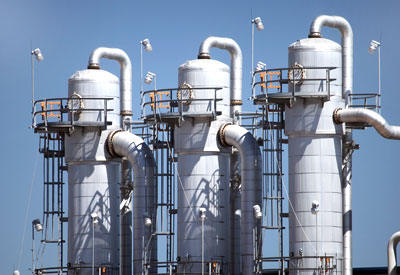Water Efficiency in the Ethanol Industry
Water use is often a limiting factor when existing facility capacity is expanded or new facilities are built. Water availability and use will depend on the plant location, quality of the water supply, and discharge limitations. With only one exception, ethanol facilities in Minnesota use ground water (as opposed to surface water) to supply their water needs. There is concern the water used by ethanol facilities will affect the ground water supplies in certain areas of the state, where aquifer extraction outpaces recharging.
As a general approximation, water use at a dry mill ethanol facility can be broken out as 70% non-contact utility water and 30% process water. Most facilities have been able to reuse all of their process water in the production process but still discharge non-contact utility water to the environment when the level of solids and salts is high in an effort to avoid damage to heat exchangers.
Although there are no regulatory limits on water efficiency for ethanol facilities, the annual amount of water removed from an aquifer by an ethanol facility is limited by its ground water appropriations permit from the Minnesota Department of Natural Resources. The concern about water use at ethanol facilities has brought an important water efficiency issue forward in Minnesota. While an important efficiency goal, conservation cannot rely exclusively on increased rates of recycling non-contact utility water; this practice produces higher levels of total dissolved solids (TDS) which may prevent the plant from meeting their water quality discharge limits.
Best Practices for Ethanol Facilities
The three technologies listed below are a few best practices for water efficiency in ethanol facilities. To view the complete list, see the MnTAP fact sheet, Best practices for dry mill ethanol plants: water quality and efficiency, or the MnTAP report, Ethanol Benchmarking and Best Practices.
No-Contact Steam Systems vs. Direct Injection
With these systems the condensed steam is returned to the boiler and reused versus being injected into the process and then later evaporated in the grain drying process. The best example is in the starch conversion process where the jet cooker typically uses direct steam injection to heat the mash, but some facilities will heat the mash using heating coils where the condensate is returned to the boiler.
Municipal Wastewater Reuse
An ethanol plant may be able to use the discharge from a wastewater treatment plant (WWTP) for non-contact cooling water use. They may not be able to use this water for process water supply because of concerns about dried distiller’s grains with solubles (DDGS) quality degradation. A study by the Metropolitan Council Environmental Services determined that there were enough WWTP within 10 miles of ethanol facilities to provide a potential supply of 52 million gallons per day (MGD), and the current demand is approximately 6 MGD. MnTAP’s Non-contact Cooling Water (2007) fact sheet provides opportunities to recirculate cooling water through your facility.
Membrane Technology
Liquid and gaseous phase membranes can replace existing rectifiers, strippers, and mole sieves to reduce water and energy costs. The membrane system can accept ethanol from the beer column, which is only 40% to 50% ethanol, and complete the dehydration process like the mole sieve. This is compared to the mole sieve which can only accept 95% ethanol. This membrane system replaces the rectifier, stripper, and mole sieve to produce significant energy savings. This process has been demonstrated on a pilot scale in an ethanol plant in Canada, but not in a commercial scale facility.
